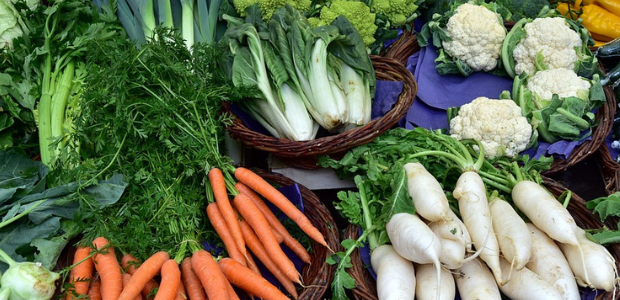A little history... Vegetables have been part of our diet for a very long time. Our Mesolithic ancestors (around 850,000 years ago) were nomadic, hunter-gatherers, and their diet consisted of meat, vegetables, fish, eggs, honey, wild cereals, wild vegetables and fruit. Mother's milk was reserved for the child. They knew how to cultivate cereals, but continued to travel in search of food.
Around the year 10000 BC, the transition from prehistory to history began. The Mesolithic gave way to the Neolithic. We move from a "savage" state to "civilization", which is characterized by a change in diet. Nomadic hunter-gatherers settled down and travelled less, becoming sedentary farmers and stockbreeders.
The human population was growing, and there were now several million people on the planet. They needed to produce their own food. As a result, these farmer-breeders had a far greater quantity of food at their disposal than hunter-gatherers.
The eight founding plants of agriculture at this time: starch (ancestor of wheat), einkorn, common barley, cultivated lentil, chickpea, cultivated pea, another variety of lentil and cultivated flax. Next come carrots and salsify.
Some historical examples:
- The potato cultivated 8000 BC in South America (Peru, Bolivia)
- Squash 13000 years before J-C in Peru
- Corn 8000 years old BC Mexico (Amerindian populations)
- Beans 6000 years old BC in Mexico
- Cocoa 2600 years BC among the Mayas of Mexico.2, 3
What is a vegan diet?
The vegan diet avoids all animal products: meat, fish, shellfish, eggs, dairy products and honey. It's an entirely plant-based diet for ethical and ecological reasons, i.e. for the well-being of animals and respect for the environment. It's a way of life, since it also bans all animal by-products such as gelatin, animal-based cosmetics, leather, wool, etc..7
Why eat more vegetables?
Vegetables are rich in phytonutrients
Our bodies develop and repair themselves through what we eat. Did you know that eating vegetables provides us with essential elements? They're rich in vitamins, minerals, fiber and water. They also play a protective role, as they're packed with phytonutrients, molecules with antioxidant properties that protect our body's cells from damage. The best-known of these are carotenoids, such as lutein, flavonoids, isoflavones, phytosterols and others. They're found in red, orange and yellow vegetables such as tomatoes, carrots, peppers, sweet potatoes and so on. They are also found in dark-green leafy vegetables such as broccoli, spinach, kale, etc.
Vegetables are rich in vitamins
First of all, the vitamins provided by the plant kingdom are compounds that the body needs in small quantities to maintain growth and function. Vitamins are sensitive to heat, light and pressure, and have a limited shelf life. Their bioavailability, i.e. the ability of these molecules to be assimilated by our bodies, is always optimized in their natural, raw form.
There are fat-soluble vitamins, including vitamins A, D, E and K. To assimilate them properly, we need to consume a certain amount of fat. Since these vitamins are stored in the liver, we must avoid excess, especially when taking supplements. Although vitamins are supplied by our diet, certain vitamins, such as vitamin K and vitamin B12, can be produced by intestinal bacteria.
B-complex vitamins and vitamin C are water-soluble vitamins. Each vitamin has different functions in the body.
Vitamins are substances involved in a wide range of biological functions: growth, bone development, digestion, ATP (adenosine tri-phosphate) production, cellular energy, vision, blood coagulation, muscle contraction, nervous and immune system function, etc.
Vegetables are a good source of minerals
Minerals help maintain cellular and extracellular fluids and the human skeleton. They include calcium, phosphorus and sodium in bones, and iron, potassium and sodium in nerve cells.
Vegetables as a source of trace elements
Trace elements are also minerals that the body needs in minute quantities. They include copper, chromium, fluorine, zinc, cobalt and silica. They are involved in a large number of enzymatic reactions. They are biocatalysts. They regulate the physico-chemical reactions that help combat cellular and tissue degeneration.
Vegetables for fiber and prebiotics
The fiber and prebiotics found in vegetables improve intestinal regularity and health. They also slow down the absorption of sugars and fats, and help hydrate fecal matter. They are involved in the production of vitamins K and B8..1, 3, 4, 5, 6
Eating vegetables every day: numerous benefits
Although the body needs around 150 times more mineral salts than trace elements, deficiencies are very common. Depleted soils can't give plants what they don't have.
What's more, the general population, children and adults alike, don't eat enough fresh vegetables. Mealtimes should contain two-thirds vegetables and one-third animal and/or vegetable proteins and/or cereals.
Plant-based foods help prevent disease and promote good health. Pulses (chickpeas, lentils, black beans, etc.) are an interesting source of vitamins, minerals, protein and fiber.
So it's important to include them in your daily meals and snacks. These various plant-based foods include fruits and vegetables, whole grains, nuts, oilseeds and legumes.
Eat more vegetables: Wholly Veggie products
Vegetables are often in the dock, Wholly Veggie was on a mission to bring good vegetables into your everyday diet. There are several new succulent and nutritious products to discover.
- Visit popcorn-style sweet potato bites sweet potato pieces with chickpea breadcrumbs and mandarin sauce
- The mozzarella-style sticks mozzarella-style fauxmage bites with cauliflower breadcrumbs and marinara sauce
- The cheddar and jalapeño sticks : from cheddar and jalapeño-style fauxmage bites jalapeño-style faux cheese bites with cauliflower breadcrumbs and a creamy sauce
Some Wholly Veggie essentials
- Complete vegetarian meals for all tastes: Sweet & Spicy Chickpeas, Southwestern broccoli
- Festive snacks to discover on arrival from work or school: Broccoli Kung Pao with a dip, Ranch Cauliflower with dip, Buffalo Cauliflower with dip
- La cauliflower pizza crust
- Different pizza preparations with cauliflower crust: Margherita pizza, Classic pizza
- Crazy vegetable patties: Sweet curry and carrots (yellow lentils, etc), Green vegetables with herbs and garlic (green beans, peas, broccoli and spinach, etc.), Southwestern beets (black beans, beets, etc.).9
Vegetables are good for your health and good for the planet!
About the author
Marie Couture, Certified Naturopath
Specialized in :
- Digestive disorders
- Inflammation
- Hormonal problems
- Stress management
References
- Arsenault Céline, Natural Care Guide for the FamilyLe Dauphin Blanc, 2015, 388 pages
- Attali Jacques, L'histoire de l'alimentationPluriel, 2021, 351 pages
- Joyeux Pr. Henri, Joyeux Jean, Food or the third medicine, François-Xavier de Guilbert, 2001, 582 pages
- Joyeux Pr. Henri, Joyeux Jean, Manger mieux et meilleur de 0 à 100 ans (in French only)éditions du Rocher, 2017, 326 pages


















